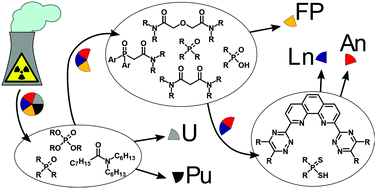Ligands for f-element extraction used in the nuclear fuel cycle
Abstract
Liquid–liquid extraction is the major technique being applied for the partitioning of f-elements from nuclear waste. In this review, the recent developments in ligand design, optimization and extraction properties are summarised for the main classes of extractants (organophosphorus ligands, diamides and N-heterocycles), with a focus on the separation of actinides and lanthanides. Structural modifications, pre-organisation and different solvent systems, as key factors for the fine-tuning of the extraction properties, are discussed. From this review, it appears that small modifications of the structure of the ligand, the pre-organising platform or the solvent can have significant impact on the extraction (and separation) of metal ions. Interest in the combinations of ligands for the extraction processes is growing, since they provide improvements over individual ligands. Similarly, unconventional approaches are being pursued to develop more efficient and greener processes.



 Please wait while we load your content...
Please wait while we load your content...